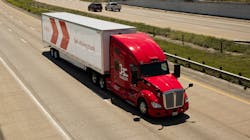While AV rivals go public, Kodiak is poised to grow with private influx of cash
With its larger rivals going public this year, Kodiak Robotics could be one of the last privately held self-driving trucking companies left by 2022. That’s just where Kodiak's CEO and founder, Don Burnette, wants to be.
“It’s a great place to be,” he told FleetOwner this week in advance of Kodiak’s announcement that it oversubscribed its Series B fundraising, bringing its private investment total to $165 million since 2018. “We're definitely one of the smaller teams in the space, and we recognize that now is the time for us to really break out and grow.”
Part of that growth includes launching a commercial self-driving service in the next few years as Kodiak expands its freight services beyond Texas, where it started hauling freight between Dallas and Houston. Its autonomous network recently expanded to San Antonio. “We feel its incumbent upon us to showcase how capable our technology is by expanding to broader lanes,” Burnette said. That will come by working with more customers as Kodiak looks to become a “coast-to-coast” operation.
Burnette said his company is working to show fleets what its technology is capable of. “We’re showing fleets what an AV-enabled future looks like at a smaller scale,” he said. “Then we’ll gradually ramp up over the next couple of years. Once the technology is ready for primetime, we want to actually supply it as a service to the private fleets and carriers that already run massive trucking organizations.”
The trucking technology company had set out to allocate $100 million in Series B fundraising, which would have more than doubled the $40 million it got during its Series A fundraising in 2018. “We really got an overwhelming amount of interest in the company,” Burnette said. “As a result of that, we decided to upsize the round to $125 million.”
‘Everybody’s talking about self-driving
Aurora became the latest self-driving trucking company to go public last week after TuSimple set the path for an autonomous startup IPO earlier this year. Both are trading on Nasdaq. Embark Trucks entered into a business combination agreement with a publicly traded special acquisition company this summer.
Burnette told FleetOwner that Kodiak had to turn away investors for this round as interest in autonomous trucking technology increases. “This space is really exciting right now,” he said. “Everybody’s talking about self-driving—self-driving trucks are front and center of folks’ minds—particularly in the investment community.”
“There’s a massive need for autonomous technology in the commercial long-haul space, particularly with the massive driver shortage” that American Trucking Associations recently pegged at 80,000 drivers, Burnette said. ATA said that the shortage could double by the decade’s end.
“This is a technology that really matters for our economy. So folks are following it very closely. And there’s a lot of excitement about that,” he said. “Kodiak is one of the last self-driving trucking private companies out there. So, certainly over the last four to six months, we’ve seen a tremendous surge in interest from folks trying to be a part of it.”
The latest round of investors includes SIP Global Partners, Lightspeed Venture Partners, Battery Ventures, CRV, Muirwoods Ventures, Harpoon Ventures, StepStone Group, Gopher Asset Management, Walleye Capital, Aliya Capital Partners, and others. These are on top of previous investments from Bridgestone Americas and BMW i Ventures.
After watching self-driving rivals TuSimple and Aurora go public this year, Burnette said Kodiak is “always thinking about” its options. “But I think there are also some advantages to being a private company at this stage,” he said. “One, we get to hold our cards close to our chest, which is a large advantage in many ways. And also, there’s some scarcity from private-only investors who want to make a play in the self-trucking industry—but there are fewer and fewer options to choose from. So we aren’t publicly talking about what our specific plans are, but we’re always considering all the options on the table.”
Kodiak, which unveiled its Generation 4 truck in September, plans to use the Series B funds over the next year to double employee headcount by adding at least 85 new people to the team, expand autonomous service capabilities from coast-to-coast, and add a minimum of 15 new trucks, which would increase its fleet to 25 autonomous vehicles.
The Gen4 self-driving Class 8 tractor combines lidar, radar, and camera technologies from Kodiak’s engineers and other industry partners. The Kodiak Gen4 truck feature Luminar’s Iris lidar, ZF Full Range Radar, Hesai 360-degree scanning lidars for side- and rear-view detection, Cummins X15 Series engines, Bridgestone Americas smart-sensing tire technology, and the NVIDIA DRIVE platform. All of this is built into Kenworth tractors.
About the Author
Josh Fisher
Editor-in-Chief
Editor-in-Chief Josh Fisher has been with FleetOwner since 2017. He covers everything from modern fleet management to operational efficiency, artificial intelligence, autonomous trucking, alternative fuels and powertrains, regulations, and emerging transportation technology. Based in Maryland, he writes the Lane Shift Ahead column about the changing North American transportation landscape.


